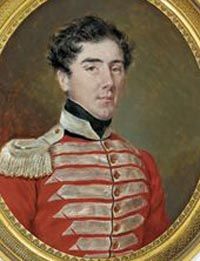General Henry Dundas, 3rd Viscount Melville GCB (25 February 1801 – 1 February 1876)[1] was a senior British Army officer and peer.
Henry Dundas, 3rd Viscount Melville | |
|---|---|
 Henry Dundas, 3rd Viscount Melville | |
| Born | 25 February 1801 |
| Died | 1 February 1876 (aged 74) |
| Allegiance | |
| Service | |
| Rank | General |
| Commands | Commander-in-Chief, Scotland |
| Battles / wars | Rebellions of 1837–1838 |
| Awards | Knight Grand Cross of the Order of the Bath |

Military career
editThe eldest son of Robert Dundas, 2nd Viscount Melville, and his wife Anne, Dundas joined the Army as a lieutenant in the 3rd (or Scots) Guards in 1819.[2] He was promoted to captain of the 83rd Regiment in 1824, major in 1826 and lieutenant-colonel in 1829. In 1837 he was active in suppressing the Canadian rebellion at the Battle of the Windmill, after which he was appointed colonel and aide-de-camp to Queen Victoria in 1841.[2]
He played a distinguished part in India as a brigadier-general in 1848–49, chosen to command the column sent from Bombay to co-operate with Lord Gough's army in the Second Anglo-Sikh War. He was second in command at the capture of Multan and then joined the main army with his force for the battle of Gujrat.[2]
He returned to England in 1850 and became 3rd Viscount Melville on his father's death in 1851. He became Commander-in-Chief, Scotland in 1854[3] remaining in that post until 1860, in which year he was made Governor of Edinburgh Castle.[2] He was raised to the rank of general in 1868.[2]
He died unmarried at Melville Castle, near Edinburgh in 1876. He is buried in the simple Dundas Vault in Old Lasswade Kirkyard, together with his ancestors and descendants.
His younger brother, Richard Saunders Dundas, was a prominent naval officer.
He was succeeded as Viscount Melville by his brother Robert.
Parliament
editHe was a Member of Parliament (MP) for Rochester from 1826 to 1830,[4] and for Winchelsea from 1830 to 1831.[5]
Arms
edit
|
Street names
editThe re-routed and extended Dundas Street West and East, in the City of Toronto, is named after him.
References
edit- ^ Leigh Rayment's Peerage Pages – Peerages beginning with "M" (part 3)[self-published source] [better source needed]
- ^ a b c d e "Henry Dundas, 3rd Viscount Melville". Oxford Dictionary of National Biography. Retrieved 29 November 2014.
- ^ "The new army list and militia list January 1855". Retrieved 1 December 2014.
- ^ Leigh Rayment's Historical List of MPs – Constituencies beginning with "R" [dead link]
- ^ Leigh Rayment's Historical List of MPs – Constituencies beginning with "W" (part 4)
- ^ Burke's Peerage. 1878.
- This article incorporates text from a publication now in the public domain: "Dundas, Henry (1801–1876)". Dictionary of National Biography. London: Smith, Elder & Co. 1885–1900.